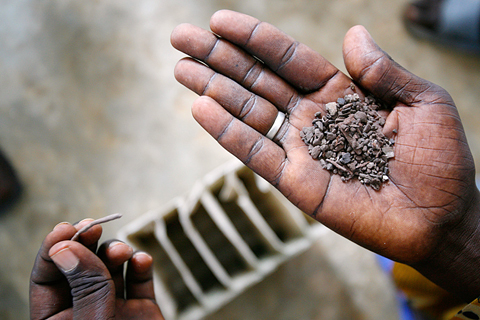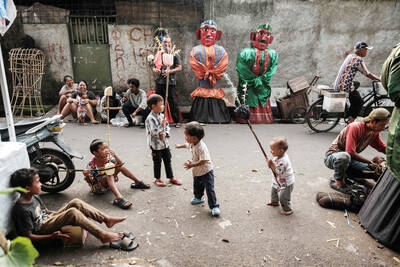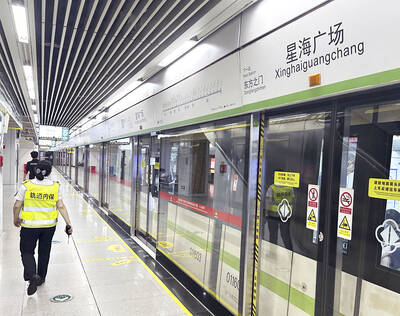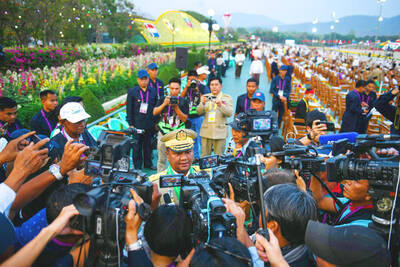First, it took the animals.
Goats fell silent and refused to stand up. Chickens died in handfuls, then en masse. Street dogs disappeared.
Then it took the children. Toddlers stopped talking and their legs gave out. Women birthed stillborns. Infants withered and died.

PHOTO: AP
Some said the houses were cursed. Others said the families were cursed.
The mysterious illness killed 18 children in this town on the fringes of Dakar, Senegal’s capital, before anyone in the outside world noticed. When they did — when the TV news aired parents’ angry pleas for an investigation, when the doctors ordered more tests, when the West sent health experts — they did not find malaria, or polio or AIDS, or any of the diseases that kill the poor of Africa.
They found lead.
The dirt here is laced with lead left over from years of extracting it from old car batteries.
As the demand for cars has increased, especially in China and India, so has the demand for lead-acid car batteries. About 70 percent of the lead manufactured worldwide goes into car batteries.
Both the manufacturing and the recycling of these batteries has moved mostly to the Third World. Between 2005 and 2006, four waves of lead poisoning involving batteries were reported in China. And in the Vietnamese village of Dong Mai, lead smelting left 500 people with chronic illnesses and 25 children with brain damage before the government shut it down three years ago, said San Francisco-based OK International, which works on environmental standards for battery manufacturing.
For years, blacksmiths in Thiaroye Sur Mer — a town of 100,000 — extracted lead from car batteries and remolded it into weights for fishing nets. It’s a dangerous, messy process in which workers crack open the batteries with a hatchet and pull small pieces of lead out of skin-burning acid. The work left the dirt of Thiaroye dense with small lead particles.
Then the price of lead climbed, and traders from India came and asked about the dirt. They offered to buy bits of lead by the bag for US$0.60 a kilogram, said Coumba Diaw, a middle-aged mother of two.
So Diaw dug up the dirt with a shovel and carried bags of it back to her house. There, she sat outside and separated out the lead with a sifter. It took just an hour of sifting to make what she did in a day of selling vegetables at the market. She kept her two daughters nearby as she worked.
Then the sicknesses started. The deaths came, one after another, over the five months from October 2007 through March last year.
At first, people thought it was malaria or tuberculosis. Doctors at the local health clinic kept seeing the same symptoms with no response to treatment and started running more tests.
That’s when Demba Diaw’s four-year-old daughter died. First she got a bad fever. Then she started vomiting. Diaw, a 31-year-old teacher at an Islamic school, thought it was malaria and took her to the hospital. The next day she was dead.
Diaw started talking to other parents whose children had the same symptoms. They were spending more money each day for more lab tests but not getting any answers. So he called the local media and held a news conference to demand an investigation.
At about the same time, the hospital confirmed lead poisoning.
The WHO was called in.
The government ran blood tests on relatives of the dead children.
Their mothers and siblings were found to have lead levels of 1,000 micrograms per liter. As little as 100 micrograms per liter can impair brain development in children.
A cleanup started in March, but was not extensive, residents say.
About 950 people have been continuously exposed to lead dust in the neighborhood, and many children show signs of neurological damage, the WHO said. The sifting tossed lead particles into the air where people could inhale it.
In richer countries, recycling of lead batteries is regulated.
Although North America and Europe continue to be the world’s biggest buyers of cars, fewer and fewer car batteries are made there. Manufacturing has moved where labor is cheaper and environmental protections regulations are more lenient.
Workers there confirm that they ship the lead and batteries out of the country but won’t give further details. The owner declined a number of requests for an interview.
The government has stripped the top layer of dirt from the roads and is paying the hospital bills of anyone sickened by the lead.
The WHO has said there’s still so much lead in the ground that the area is toxic. The government wants to relocate the entire neighborhood. But Demba Diaw said the government just wanted to profit from the lead in their earth and Coumba said this was her only home.
Like many other families, the Diaws are too poor and too rooted to move. So they will stay where lead poisons the earth.

In the sweltering streets of Jakarta, buskers carry towering, hollow puppets and pass around a bucket for donations. Now, they fear becoming outlaws. City authorities said they would crack down on use of the sacred ondel-ondel puppets, which can stand as tall as a truck, and they are drafting legislation to remove what they view as a street nuisance. Performances featuring the puppets — originally used by Jakarta’s Betawi people to ward off evil spirits — would be allowed only at set events. The ban could leave many ondel-ondel buskers in Jakarta jobless. “I am confused and anxious. I fear getting raided or even

Eleven people, including a former minister, were arrested in Serbia on Friday over a train station disaster in which 16 people died. The concrete canopy of the newly renovated station in the northern city of Novi Sad collapsed on Nov. 1, 2024 in a disaster widely blamed on corruption and poor oversight. It sparked a wave of student-led protests and led to the resignation of then-Serbian prime minister Milos Vucevic and the fall of his government. The public prosecutor’s office in Novi Sad opened an investigation into the accident and deaths. In February, the public prosecutor’s office for organized crime opened another probe into

RISING RACISM: A Japanese group called on China to assure safety in the country, while the Chinese embassy in Tokyo urged action against a ‘surge in xenophobia’ A Japanese woman living in China was attacked and injured by a man in a subway station in Suzhou, China, Japanese media said, hours after two Chinese men were seriously injured in violence in Tokyo. The attacks on Thursday raised concern about xenophobic sentiment in China and Japan that have been blamed for assaults in both countries. It was the third attack involving Japanese living in China since last year. In the two previous cases in China, Chinese authorities have insisted they were isolated incidents. Japanese broadcaster NHK did not identify the woman injured in Suzhou by name, but, citing the Japanese

RESTRUCTURE: Myanmar’s military has ended emergency rule and announced plans for elections in December, but critics said the move aims to entrench junta control Myanmar’s military government announced on Thursday that it was ending the state of emergency declared after it seized power in 2021 and would restructure administrative bodies to prepare for the new election at the end of the year. However, the polls planned for an unspecified date in December face serious obstacles, including a civil war raging over most of the country and pledges by opponents of the military rule to derail the election because they believe it can be neither free nor fair. Under the restructuring, Myanmar’s junta chief Min Aung Hlaing is giving up two posts, but would stay at the